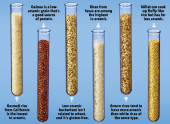




"the qualities of these bacteria, like the heat of the sun, electricity, or the qualities of metals, are part of the storehouse of knowledge of all men. They are manifestations of the laws of nature, free to all men and reserved exclusively to none." SCOTUS, Funk Bros. Seed Co. v. Kale Inoculant Co.




rookie wrote:
Hey, how did you know about this? How can I find out more about Native American agriculture? I'm very interested and all I can find on the internet are things about corn and buffalo.
"the qualities of these bacteria, like the heat of the sun, electricity, or the qualities of metals, are part of the storehouse of knowledge of all men. They are manifestations of the laws of nature, free to all men and reserved exclusively to none." SCOTUS, Funk Bros. Seed Co. v. Kale Inoculant Co.




rookie wrote:
Hey, how did you know about this? How can I find out more about Native American agriculture? I'm very interested and all I can find on the internet are things about corn and buffalo.
Find me running the NW Restoration group page on Facebook - a communal effort to share information about permaculture, ecological restoration and sustainability in the great Northwest!








mos6507 wrote:
Agriculture as it is now is a Faustian bargain, a Malthusian trap, as it were. Traditional cost analysis is a short-term proposition. Income stream vs. expense stream. Sustainability refers to larger timescales, and that's where we're most vulnerable.




Dianne Keast wrote:What if the first logging industry in the US had been set up in a sustainable fashion??
"the qualities of these bacteria, like the heat of the sun, electricity, or the qualities of metals, are part of the storehouse of knowledge of all men. They are manifestations of the laws of nature, free to all men and reserved exclusively to none." SCOTUS, Funk Bros. Seed Co. v. Kale Inoculant Co.








paul wheaton wrote:
If you said that to Sepp Holzer, he would probably slap you silly.
Based on his teachings, I would say that you could measure on the dollar value alone. In fact, measure your organic, first rate product against the cheapest crap you can find and you should still come out dollars ahead. By far.
Think about it: plant once and harvest year after year without any further effort other than the harvest. Doing the harvest on your own land has to be way easier than going to the store.
Yesterday Sepp was exasperated about all these American fools who still go to the grocery store and spend obscene amounts of money for horrible food when they could have first class food from home for damn near free.













Joel Hollingsworth wrote:
I've been improving some mostly-unused public land near me.
I'd put the cost at $0.20 in seed (fava beans from the grocery bulk bin) and maybe two hours of labor thus far.
Next year I might do a soil test, or just decide to grow non-edibles. Perhaps I should talk to whoever planted the tomatoes at the edge of it, either way.
I won't invest much in it, because I'll never really control it, but it's way better odds than a lottery ticket.
QuickBooks set up and Bookkeeping for Small Businesses and Farms - jocelyncampbell.com




Susan Monroe wrote:
I believe food stamps can still be used to buy vegetable seeds, but how many welfare people do you know who grow anything? I've never seen one. But I've seen them at the grocery store with a ton of junk food.
Real food is too much like work for some people.
Sue

|
Arthur, where are your pants? Check under this tiny ad.
Support permies and give beautiful gifts to gardeners: permaculture playing cards.
https://gardener-gift.com/
|






